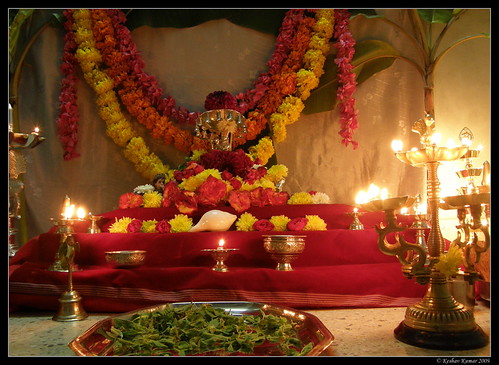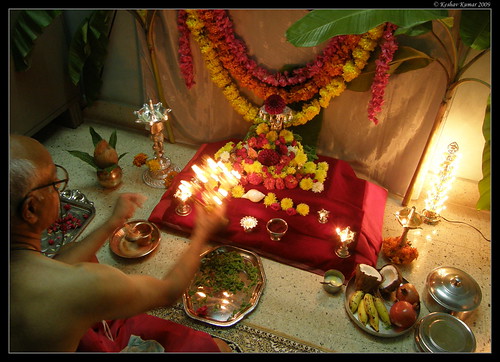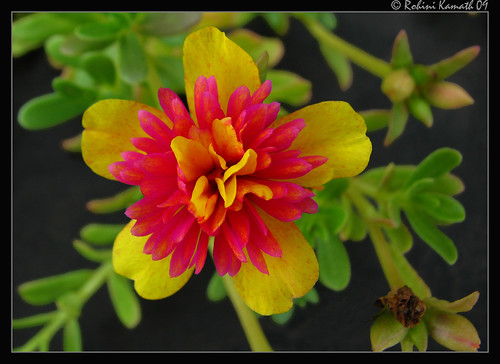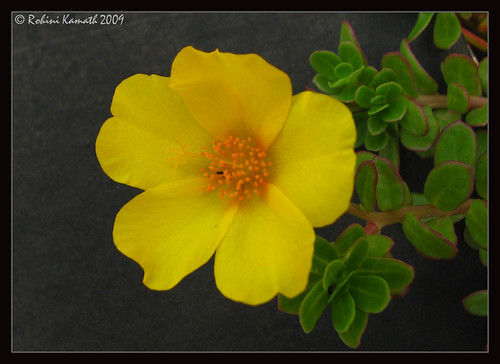
Mom lighting Maha-aarti lamp
Krishna Janmashtami Pooja is performed to celebrate the birth of Lord Krishna.
According to info gathered from my Dad, it is observed on the eighth day, (hence it is called Ashtami ) Ashtami tithi, of the dark half or Krishna Paksha of the month of Shravana in the Hindu calendar, when the Rohini Nakshatra is ascendant. Note: Wikipedia seems to believe it is Bhadra month.
We always perform the pooja ourselves at home, this time I decided to document some parts of it. I have also prepared basic lists of items needed for general convenience.
For GSBs, the Janmashtami day is awaited eagerly mostly for the varieties of yummy food that is prepared. Traditionally 108 different delicacies are offered to the Lord at midnight, and then happily consumed by hungry devotees. For those operating on a budget, 56 dishes are offered (chappan bhog). Ofcourse, in our recession-hit days even this seems a bit much. So we settled for 12.

Our Mantap was decorated this way
Janmashtami Pooja generally takes the form of welcoming the Lord as one would a guest. As in most poojas, only males who wear the sacred thread (after "Moonji"/Upanayana) perform the pooja. ( This is probably because the ladies were too busy with all the cooking )
My Dad follows procedures as mentioned in a well-thumbed kannada book (Sri Krishna Janmashtami by Prabhakar Press Ltd, Udupi) and the pooja is performed in sanskrit.
Significant parts follow:
Note: Samarpayami means "I offer". After each part is over, the person doing the pooja announces which part is offered, as below.
1. Dhyaanam Samarpayami (Think or meditate on the Lord)
2. Aawaahanam Samarpayami (Invite the Lord into your home/heart)
3. Aasanam Samarpayami (Offer a seat)
4. Paadyam Samarpayami (Offer water to wash the feet)
5. Arghyam Samarpayami (Offer water to wash the hands)
6. Aachamanam Samarpayami (Offer water to drink)
7. Snaanam Samarpayami (Give bath)
8. Maha Abhishekam Samarpayami (Main head bath)
9. Vasthram Samarpayami (Offer clothes)
10. Yajnopaveetham Samarpayami (Offer the Holy Thread)
11. Gandham Samarpayami (Offer sandlewood paste/powder)
12. Bhushanam Samarpayami (Offer ornaments)
13. Akshatham Samarpayami (Offer Akshatha (rice))
14. Pushpam Samarpayami (Offer flowers)
15. Vishnu Sahasrananam jape viniyogaha ( 1000 names of Lord Vishnu )
16. Ashthothtra Namajape Viniyogaha (108 names of Krishna)
17. Dhoopam Samarpayami (Offer fragrance)
18. Deepam Samarpayami (Offer light)
19. Neivedyam Samarpayami (Offer food)
20. Phalam Samarpayami (Offer fruits)
21. Taamboolam Samarpayami (Offer betel nut and leaves )
22. Dakshinam Samarpayami (Offer wealth)
23. Maha Mangalaarati Samarpayami (Perform aarti)
24. Pradakshinam Samarpayami (Circumambulate the Idol)
25. Namaskaran Samarpayami (Prostrate before God)
26. Praarthanaam Samarpayami (Offer prayers, request your desires)
27. Xamaapanam Samarpayami (Ask for forgiveness in case of goof-ups)
In places where the offering mentioned is not available, a tulsi dul (leaf pair) is offered instead.
Running Time of Pooja
Usually 1 hr 30 min and 30 min for aarti
( we have 3 aartis; 10 min per aarti )
Many of the lord's names are tongue twisters so it may run longer if you stumble on each name.

Dad performing pooja, doing the aarti
Neivedyam
As in any pooja, everyone knows the most important part is the prasad. It is prepared before hand (and only after the person who is preparing it has bathed). It is not tasted before offering it to god.
What my Mom prepared this year:
a. Churmundo
Laddoo of wheat flour (90%) and besan (10%) (gram flour)
with powdered sugar, ghee, cardamom and raisins
b. Panchakajjai (easy to make)
Panchakajjai Recipe:
1. Bengal gram (roasted and powdered )
2. White Sesame seeds ( roasted)
3. Coconut scrapings
4. Jaggery powder
5. Cardamom powder
6. Ghee (optional)
Mix 3,4,5 together. Add 1 and 2 to this mixture.
Put optional 1-2 tbl spoons ghee on top for aroma.
Pooja Item List
If you do not have Silver/Copper items as below , substitute stainless steel.
Clean and polish :
1. Kalash (Silver/Copper)
2. Tamhan/Purnapatra (Silver/Copper) - plate
3. Panchpatra/Bhande (Silver/Copper) - bowl and spoon
3. Shimudra (Silver/Copper) - religious stamps
4. Shankha - Conch Shell for blowing
5. Argya Shankha - to offer argya - small Conch Shell ( cannot be used for blowing )
6. Ghaanta (Brass/Silver) - Bell
7. Jhaghanta (Brass) - Gong with striker
8. Diyas (Silver/ Brass) - Ghee/Oil Lamps - ( 1 large, 1 small ) Add more for decoration.
9. Brass Aaarti lamps ( more the merrier )
10. Agarbhatti stand ( silver / brass )
11. Mantap ( silver / white metal / brass ) - optional

Old Brass Oil Lamp Vs. LED Lamp
Buy :
1. Flowers in trays ( separate for alankara , malas for decoration )
2. Mango leaves thoran ( for hanging on door ) and bunch of 5 for putting in kalash
3. Plaintain leaves ( for eating on )
4. Kaeli pair - 2 Baby Banana plants ( for decoration )
5. Coconut - minimum 2 - 1 to be in kalash, one to be broken later as prasad
6. Tulsi dul in a tray (min. 108 or 1001) - tip of tulsi branches having only 2 leaves.
7. Any Fruits in silver plates (or trays) - in odd numbers, eg. 1 bunch of 5 bananas (do not separate from each other)
Other Items:
1. Ghee
2. Oil
3. Panchamrat items in separate bowls - ghee, honey, milk, dahi, sugar
4. Sacred thread double ( for married person) - ( for the god )
6. Drinking Water in a bowl / pot
7. Gandham - Sandalwood paste
8. Gopichandan (Gopchannan in konkani) - Cream coloured paste for use with shimudhram
9. Akshatha - raw rice ( 2 tbl spoon in a bowl )
10. Kunkum in silver bowl
11. Agarbhatti / dhoop ( with stand )
12. Vaathi ( Cotton wicks ) for arti and lamps
13. Matchbox
14. Rags for wiping up
15. Machette / Koithi in konkani - Heavy blunt object to split the coconut
16. Big bowl to collect coconut water
17. Pooja procedure book with mantras ( Important! )
Decoration
Mantap and the idol in it, should face east.
1. Thread for tying up decorations
2. Scissors
3. Creating a mantap ( we use slabs of thermocol to make a small stage )
4. Manai ( wooden seat) / Mats - to seat the person(s) performing pooja
5. Cloth lengths for decoration (usually hung as a screen behind the mantap)
6. Carpet to seat the rest of the household.
Attire
Only the people performing the pooja need follow the dress code :
Pattetodopu ( silk dhoti and shawl ) for the gents ( essentially unstitched cloth )
Usually, they bathe, dress and sit for pooja immediately.
Fasting
The persons involving themselves in the pooja are required to fast. Fasting in this case is defined as abstaining from consuming meat, onion, garlic and carbohydrates (lepu). Water, all Milk products, fruit, vegetables, food grains like lentils may be consumed.
[ Note: Since Paneer is made from splitting milk, this is considered inauspicious among hindus. Paneer is an introduced food to North-India ( came from Afghanisthan, I read this in Al Basham's The Wonder that was India ). You may want to keep away from the cheeses, if you want to be true to the fast ]
THE FOOD
After pooja is over, dinner is served. Our menu this year :
Note : no onion or garlic is used. In temples, hing (asofetida) is also not used.
1. Pickle - mixed veg
2. Green beans Palya ( upkari ) Garnished with coconut scrapings, tadka : redchillies and mustard
3. Plain Papad
4. Aalwati ( masala randhai(curry) of Arbi/Arvi leaves )
5. Karathe Ambade Ghasshi ( Karela and sour ambado masala curry )
6. Tori and Jeev Kadgi Ghasshi ( Whole White Tur and Breadfruit masala curry )
7. Pooli Koddhel ( Koo-waa-lain - White Pumpkin in spicy tamarind curry )
8. Rice ( keep ghee handy )
9. Rasam
10. Daali Thoy ( Simple Dal - hing, mustard, curry leaves, green chillies )
Sweets
11. Madagane ( Sweet - Chana Dal and Cashew stewed in thick coconut milk and jaggery )
12. Pattholi ( Sweet - Rice Rolls stuffed with coconut, jaggery and cardamom. Wrapped in turmeric leaves and steamed )
Dinner is served on plaintain leaves.
Place leaf with smaller end on the left hand side of the seated person.
Serve salt first, then follow the order as in list above.
Regrettably, after food was served, I completely forgot to take pictures. So sadly, I have no pictures of the divine tasting things mentioned above. But I assure you it was yum! It was only after dinner, on a full tummy, that we remembered the camera.
Keshav and I forgot to bring our Cameras; so all photos were taken by Keshav, on my parent's Olympus-SP550UZ.
For Pooja with limited time and resources :
Short-Cuts
1 diya ( if not oil/ghee, at least LED )
1 arti ( use a plate with karpur or give arti with the diya )
1 tulsi dul ( pick it from your own plant )
1 flower ( pick it from your own plant )
Fruit ( im sure there is some fruit in the house, 1 coconut would be great too )
Agarbhatti
kumkum
Sugar as nivedhyam
Dont forget to have bath and fast.
Read the ashtotar. If there are several people and you are in hurry, it can be divided, in a Divide and Conquer Strategy eg. 25 each
For even shorter pooja, it is sufficient to say the following.
Krishna Krishna Hare Hare,
Hare Rama Hare Rama,
Rama Rama Hare Hare"
There is no shortcut for food :)
Helpful Links:
VishnuSahasranamam: (1000 Names)
compiled with 108 slokhas (versus) that contain the 1000 Names of Sri Mahavishnu.
http://www.trsiyengar.com/id70.shtml
Asthotharam: (108)
http://iworld4you.com/sri-krishna-ashtothara-sathanamavali-108-names/
Tamil Versions
Interactive learning and video:
http://www.slokas.com/slokas/vedicrituals/tamil/poojas/gokul.html
Procedure:
http://www.slokas.com/slokas/vedicrituals/tamil/poojas/pooja/janmashtami13.html
Sources:
http://www.netglimse.com/holidays/janmashtami/how_to_do_janmashtami_puja.shtml








